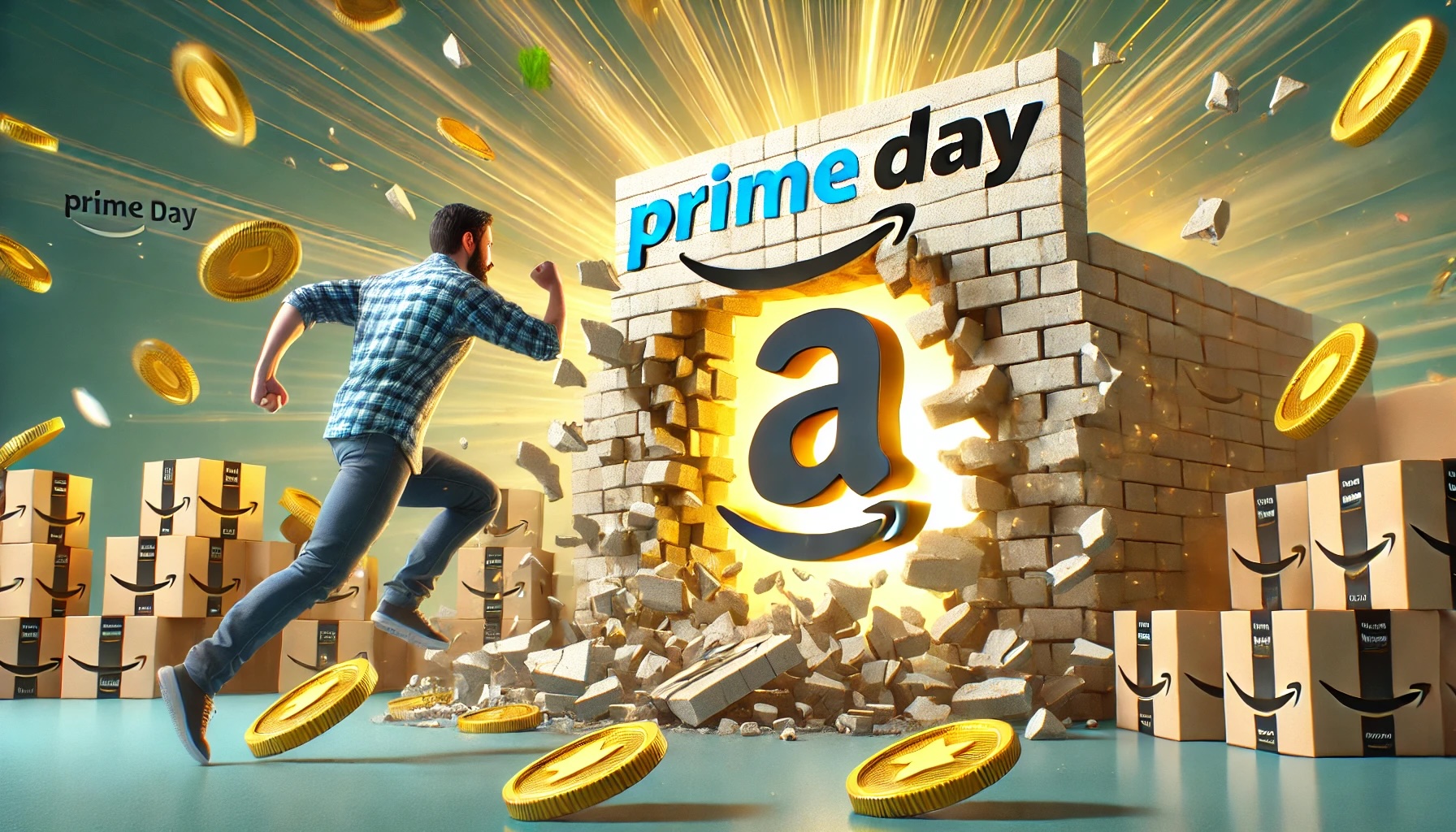How to Improve Your Amazon Ranking in 2024
Master Listing Optimization and Sales Velocity: The Dual Keys to Boosting Your Amazon Product Ranking in 2024.

As an Amazon seller, you want to reach as many interested shoppers as possible. The key is understanding how Amazon decides where your products end up in search queries that originate from their platform.
Amazon uses a formula to help them determine which listings are first shown to shoppers that’s called an Amazon BSR. Amazon says that their “Best Sellers Rank is based on Amazon sales, and is updated hourly to reflect recent and historical sales of every item sold.”
The Amazon A9 algorithm focuses on a number of direct and indirect factors to help determine your BSR as well as your Amazon product ranking. However, two of the most important considerations are On-Page Optimization, and Sales Velocity (often derived through pay-per-click advertising).
On-page optimization refers to everything from image quality to the relevancy of your listing copy. Sales velocity is all about your number of sales within a given time period.
This guide on keyword research, ranking strategy, listing optimization, and A+ content will help give you a basic game plan for quickly improving click-through and conversion rates that you need to sell on an increasingly competitive marketplace.
Thinking About Hiring an Amazon Management Agency?
Canopy’s Partners Achieve an Average 84% Profit Increase!
Let’s talkUnderstanding Amazon’s Algorithmic Intent
Don’t forget that Amazon is both a search engine and an ecommerce platform.
Look at it this way…
On Google, there may be a number of reasons why a user is searching “traditional Irish folk music.” They could be doing research for a project, trying to jog their memory about a particular performer, or looking to buy an album.
Unlike Google, Amazon assumes everyone is interested in making a purchase.
That’s why it’s in Amazon’s best interest to match each search with the products that are most likely to end in a sale.
It makes sense, then, that to improve your Amazon sales rank, and get the Amazon Buy Box, there is another ranking factor to consider. To precisely reach the right shoppers and convince them to buy, it’s crucial that your advertising strategy and product detail page are fully optimized.
But, there’s a problem where Amazon product optimization is concerned. Amazon sellers are often under the false impression that their listings are fully optimized. Unfortunately, in most cases, they’re not.
This post is also intended to give you the tools you need to make sure both your Amazon PPC and SEO strategies are working together to not only boost visibility but also maximize sales.

Begin With Keyword Research
How do you get your Amazon product listing in front of the right shoppers? It starts with understanding the intent behind the searches that lead to your product.
Keyword research is vital for any ranking strategy. It reveals what your target audience is searching for, allowing you to create content that meets their needs. By understanding keyword relevance, search volume, and competition, you can prioritize topics that drive organic traffic. Keyword research uncovers new content opportunities, clarifies search intent, and keeps you ahead of industry.
These are the basic steps:
Create a List of Seed Keywords: Begin with short phrases (1-3 words) that describe your product. If you need ideas, use Google’s related search terms.
Explore Amazon’s Search Bar Suggestions: Enter your seed keywords into Amazon’s search bar and note the autocomplete suggestions. These suggestions indicate popular search terms used by Amazon customers.
Utilize Keyword Research Tools: Software tools like Jungle Scout and Helium 10 can provide valuable data on search volume, related keywords, and other metrics to help you identify the most relevant keywords for your product.
Focus on Relevance: Ensure the keywords you choose accurately describe your product and match what potential customers are searching for on Amazon.
Track Your Findings: Keep a list or spreadsheet of the keywords you discover for further analysis and prioritization.
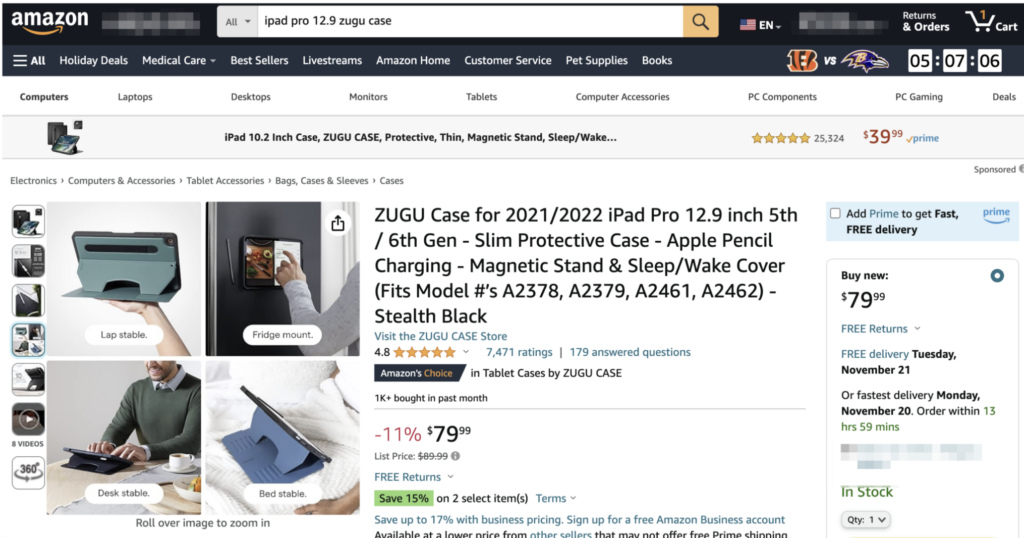
Create Keyword-Rich, Customer-Focused Listing Content
Once you’ve determined which keywords you should include in your product information and how to best utilize them in your ad campaigns, the next step will be to incorporate them into your listing content. This will help you improve your organic Amazon ranking because it will spike the relevancy of your listing in the eyes of the Amazon algorithm.
There are four opportunities to weave your keywords into your Amazon listing:
- Product Title
- Key Product Features
- Product Description
- Backend Search Terms
Be careful, though!
Remember that you’re not just writing for the Amazon algorithm. You’re writing for (human) Amazon shoppers. To rank well, you need to strike a balance between SEO copywriting and persuasive, customer-focused language that appeals to your target audience. Amazon has recently adjusted their algorithm to favor listings that appear to be written for people not computers.
Thinking About Hiring an Amazon Management Agency?
Canopy’s Partners Achieve an Average 84% Profit Increase!
Let’s talkProduct Title
They say that it only takes 5-10 seconds of meeting someone new to form a first impression. The same is probably true of an Amazon sale. That’s why your product title is so important.
While you have a limit of up to 200 characters, only the first 5-10 words in your product title are what appear as a search result, making these 5-10 words the most important piece of copy for your listing.
(No pressure, right?)
Let’s take a look at an example…
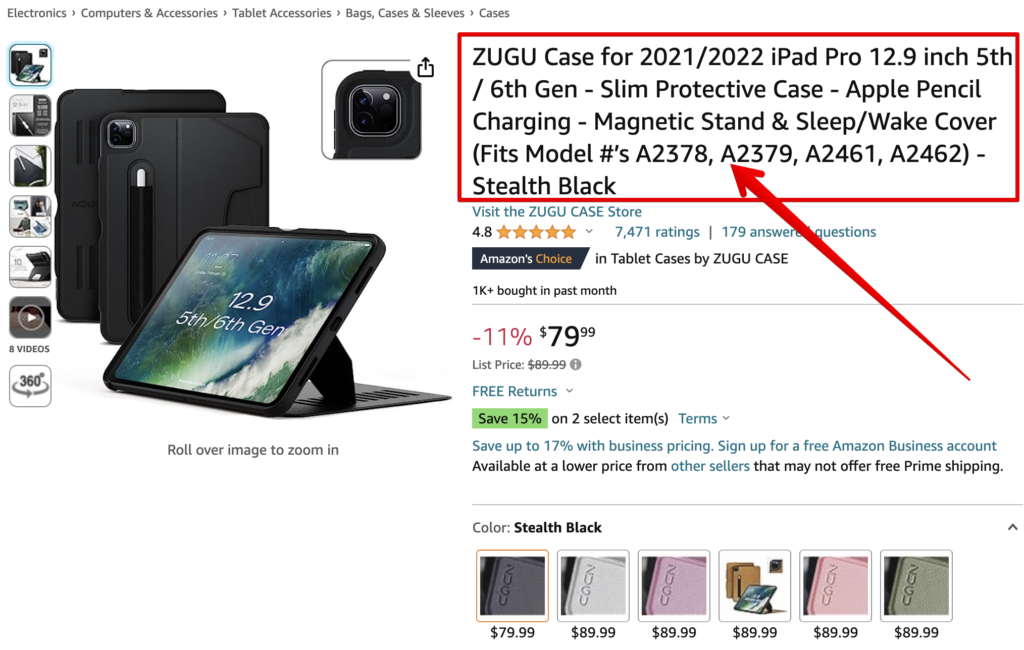
What’s great about this title is that it uses high volume, relevant keywords (“slim protective case” and “Apple pencil charging”) while also keeping the copy customer-focused. It also uses dashes to break up the text and make the information easy to understand at a glance.
Key Product Features
Trying to get your entire product description and targeted keywords into the tight 200 characters of the product title can be challenging. That’s why you have much more space to make your point after the shopper has reached your product page.
Topping off at a 1000-character limit, Amazon’s product features section gives you a bit more room to stretch your legs, but you still need to use that space wisely.
Your product features should be formatted as a bullet point list and include key product benefits. Bullet points make it easy for a reader to quickly scan the words for key information, which is why it’s the standard format for Amazon listing content.
Some sellers are tempted to use this space to list exact product specifications or manufacturer descriptions, but that approach does nothing to help you rank better or persuade your target audience of prospective customers.
A good list of key features starts each point with a key benefit that directly appeals to what your customer needs.
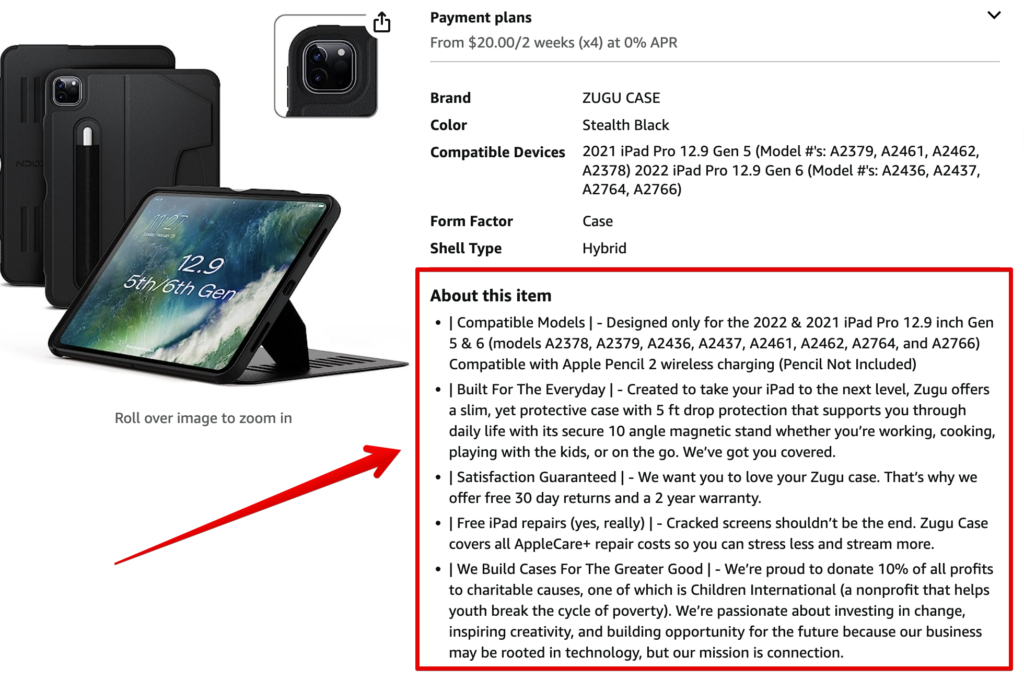
In this example, you’ll see that the copy highlights the key benefits, as well as addresses product compatibility, the company’s charitable donations, and a money-back guarantee.
Each one of these key points helps to overcome the customer’s potential objections while highlighting more specific product features and keywords (“built for the everyday,” “satisfaction guaranteed,” and “free Ipad repairs”) to support each benefit.
Amazon Product Description
Your product description section should be the area you expand on your key product features and benefits, as well as include long-tail keywords that you’ve identified in your keyword research.
The best practice for Amazon SEO is including your main keyword near the start of your product description. Plus, if you did not have an opportunity to use a keyword in your product title or key features, you can add it in the description.
Like all marketing copy, the best type of copywriting tells a narrative. It involves storytelling that shows the obstacles and challenges that a person may experience before purchasing your product and highlights how your product can solve those issues.
The language you choose should be friendly and conversational, not scientific. This section puts a little more “humanity” in your content.
Do
- Strategically incorporate relevant keywords into your copy in a way that sounds natural.
- Create a buyer persona by considering your ideal customer and what they want.
- Overcome their objections with specific product benefits.
- Highlight differentiators between your product and your competitors’. Think about what you have to offer that others don’t.
- Tell a story. Everyone loves a good story, and it can help contextualize your product to show how it might fit into your customer’s life.
Don’t
- Stuff your listing with keywords. Remember, you’re selling to humans, not to algorithms.
- Be too self-centered. Your product content should highlight how your product’s main features translate into concrete benefits.
- Follow the crowd. Instead of copying your competitors, focus on what makes your product special.
- Copy and paste a manufacturer description into your content, and call it a day.
Thinking About Hiring an Amazon Management Agency?
Canopy’s Partners Achieve an Average 84% Profit Increase!
Let’s talkBackend Optimization
Amazon sellers have the opportunity to provide more information about a product in the administrative backend of the product page.
Utilizing meta tags in your product page’s backend helps Amazon recognize the relevance of your product offering.
There’s a catch, though.
If you think that you can just throw irrelevant or unrelated keywords into the backend to drive traffic, think again! You should never use this section as a way to stuff keywords that aren’t specific to those you targeted on the frontend.
If you wouldn’t use it on the frontend, don’t put it in the backend.
Keyword stuffing on the backend will only drive your results lower by appealing to irrelevant audiences.
Backend optimization needs to be carefully crafted to include relevant keywords and be fewer than 250 bytes. (If you aren’t familiar with bytes, Amazon has a handy explanation.)
Unless you’re already experienced in this optimization strategy, an Amazon search professional can utilize it best, so consider contacting Canopy’s Listing Optimization experts for help.
Take Advantage of Amazon A+ Content
Amazon A+ Content is an often overlooked yet highly effective way for sellers to boost their brand, increase conversion rates, and improve rankings on Amazon.
This premium content feature allows Amazon Brand Registered sellers to enhance their listings with engaging images and text. Although Amazon claims A+ Content can increase sales by up to 10%, the impact may be even greater when fully optimized. By highlighting product features and benefits with scannable text, A+ Content makes listings more compelling and can appear in Google search results.
Most importantly, the sales velocity boost helps products rank higher in Amazon’s search algorithm. Sellers who overlook this powerful tool are missing out on an opportunity to stand out in the competitive Amazon marketplace.
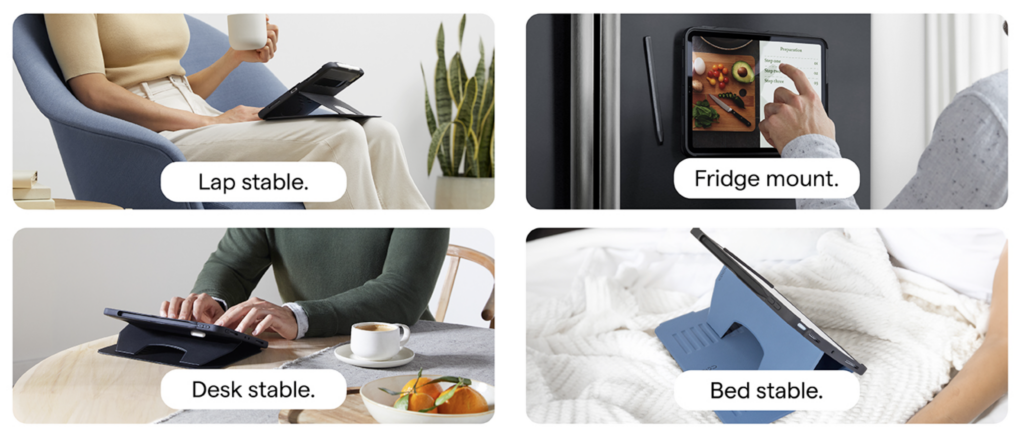
Lifestyle Images Help Shoppers Connect the Dots
High quality lifestyle images showcase products being used in real-world settings and help bring listings to life.
Lifestyle images allow shoppers to visually see how a product can fit into their lives before making a purchase. This helps set proper expectations about product size, functionality, and overall look and feel.
As a result, lifestyle images can help reduce returns from customers who realize a product does not fit their needs only after receiving it. Lower return rates help sellers maintain healthy metrics that influence future sales.
Furthermore, compelling lifestyle images capture shoppers’ attention, convey product value, and drive conversion rates. Sellers who incorporate strong A+ lifestyle imagery give shoppers a better customer experience while also boosting their own sales performance.

Don’t Forget Amazon A+ Video Content
One especially valuable component of A+ Content is video. Video content can capture shoppers’ attention and convey key product selling points. High-quality demonstration videos visually showcase how a product works and what makes it better than competitors.
Videos help shoppers make informed purchase decisions and can significantly influence conversion rates. Sellers who take advantage of A+ video give their listings a competitive edge.
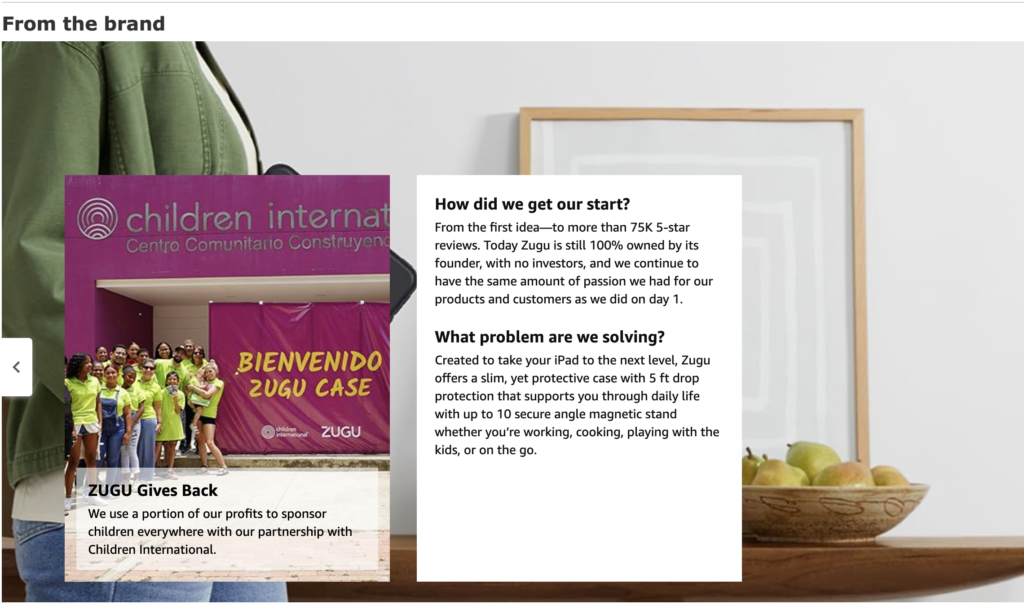
Create an Emotional Connection with Amazon Brand Story
The Amazon A+ Content Brand Story spotlight is a powerful tool for sellers to make lasting connections with customers and stand out from the competition. This dedicated section separate from the product description is titled “From the Brand” and enables you to share your brand’s origin story, core values, and unique differentiators.
Telling your brand story allows you to create an emotional connection with customers that goes beyond just selling products. It builds trust, affinity, and brand loyalty that encourages repeat purchases. The Brand Story space also provides additional real estate to promote cross-sells to other products and link to your Amazon storefront.
Unlike other forms of premium content, the Brand Story is free to access for Amazon Brand Registered sellers through the A+ Content Manager. You can seamlessly incorporate the Brand Story alongside enhanced images, videos, and text to create the full A+ Content experience.
Leveraging the Amazon A+ Content Brand Story gives your catalog a competitive edge. You can use the feature to authentically communicate what makes your business special and win over customers in Amazon’s vast marketplace.

How Keyword Strategy Helps Save On Ad Spend
Advertising on Amazon can quickly become expensive if you don’t approach it with a smart strategy that incorporates the right keywords and phrases to optimize your ads to deliver conversions and sales.
You’ll build sales velocity by optimizing your Amazon PPC ads, and those higher sales will translate into better ranking.
When it comes to Amazon advertising, it doesn’t matter if you’re talking about sponsored products, sponsored brands, or sponsored display, the Amazon ranking algorithm wants to SEE that you’re connecting the dots for its shoppers in a clear and concise way.
Your Amazon best sellers rank depends on it!
Thinking About Hiring an Amazon Management Agency?
Canopy’s Partners Achieve an Average 84% Profit Increase!
Let’s talkUse Amazon’s Algorithm to Help Find Converting Search Terms
Amazon allows advertisers to choose between 2 options for keyword targeting in their ad campaigns:
- Manual Targeting
- Automatic Targeting
With manual targeting, you choose the keywords and phrases you want to use and make your bid. That’s great if you already have high-performing keywords researched, but what if you don’t know what keywords will perform best?
The effectiveness of your Amazon ads strategy depends on your ability to answer this question.
If you want to run an inexpensive test for the types of search terms your potential customer is using, automatic targeting can help you understand the search terms that are already converting.
The benefit of using automatic targeting is that all you need to do is allocate a small budget and set your campaign to automatic targeting, and Amazon will do the rest.
Automatically running these keyword “tests” will save you time optimizing your keyword strategy because the Amazon search engine will provide you with a list of proven, high-converting terms (many of which you may not have considered) to implement in your manual campaigns.
With all the talk these days of Amazon automation, this is another way to put the ecommerce giant’s algorithm to work for you.
However, learning the right keywords to use is just the first step. After that, you need to determine how to best match them with relevant search queries to improve your overall ad performance. That’s where Amazon match types come in.
Amazon Match Types
Choosing a match type for your keywords tells Amazon how to match your keyword to related search queries. Selecting the right match type will help your ad reach the most relevant audience so that you’re not wasting money (and hurting your ranking) by serving ads in searches that aren’t likely to end in a sale.
There are four Amazon match types: Broad, Phrase, Exact, and Negative.
| May contain additional words in the middle of search term | May contain additional words at the beginning or end of search term | May contain conjunctive words (and/or) | May contain singular or plural versions of the search term | |
| Broad | ✓ | ✓ | ✓ | ✓ |
| Phrase | ✓ | ✓ | ✓ | |
| Exact | ✓ | ✓ |
Broad Match
Broad match is the most general, and it means that a search term may match if it contains all the keyword terms in any order. These keywords will often cost a lot less than other types of keywords, but if you’re not careful, they may lead to your ad appearing in irrelevant searches and fail to convert into sales.
Phrase Match
Phrase match means that the search term must contain the exact phrase or sequence of words in order to match the chosen keyword. Typically, the phrase match type gives you more control over the search terms your keyword matches for while being less expensive and restrictive than the exact match type.
Exact Match
When you choose “exact match,” you are telling Amazon that the search term must exactly match the keyword or sequence of words in order for the ad to show. Typically, because you are narrowing the type of searches your ad will appear in, exact match keywords are the most competitive and therefore, the most expensive.
Negative Match
With this type of keyword parameter, you’re telling Amazon to disregard any search terms that include the keyword you’ve identified. For example, if you’re an Amazon FBA seller of adult baseball caps and want to avoid showing up in searches for kids’ baseball caps, you’d set “kids” or “children” as negative keywords.
Amazon Doesn’t Love Low Click-Through Rates
Because click-through rate (CTR) is the ratio of people who click on your ad divided by your total ad impressions, a low CTR signals to Amazon that your ad either doesn’t appeal to shoppers or isn’t relevant to their needs.
With the latter, selecting the correct match type for your chosen keywords can make a significant difference in improving your CTR. Additionally, using negative keywords will help minimize the number of times your ad appears in irrelevant searches, again improving your overall CTR.
If your goal is to improve your Amazon ranking, tweaking your match type strategy to focus on elevating your ads’ click-through rates should be your first step. That will help you to increase conversions and build sales velocity, which will, in turn, improve your overall ranking.

Dig Into Amazon Product Reviews Using AI
Product reviews can have a lot to do with your Amazon product ranking. Here’s how to put artificial intelligence to help you determine trends and isolate the most critical keywords to focus on in your listing content.
Because AI-driven NLP algorithms can analyze large volumes of reviews to extract frequently mentioned terms, they’re able to help you spot emerging trends and popular features.
AI assigns relevance scores to keywords based on frequency, recency, and impact on customer satisfaction, helping you prioritize the most valuable keywords for your listings.
Then, take the search terms that are driving positive interactions with your own listings (as well as those of your competitors) and strategically position them in your listing copy.
How Canopy Management Can Help
What would adding 67% more organic sales mean for your brand?
Turns out that when you combine the massive experience of Canopy’s Amazon Advertising Experts with smart tools and tech, you get industry-leading results like this:
- 84% Average Year-Over-Year Profit Growth for Our Partners
- 2.7 Billion in Revenue Managed
- 99.1% Partner Retention Rate
Canopy Management is a full-service marketing agency for Amazon and Walmart sellers. Our team consists of former Amazonians, multi-million dollar sellers, and award-winning experts.
When you consider the many ways that Canopy Management can help you grow your business, you’ll see why selling on Amazon is much easier “under the Canopy.”
- Strategic Growth Planning
- Listing Copywriting Optimization
- Listing Photography
- Product Videography
- Advertising Management
- Customer Service
- Demand Side Platform (Amazon DSP)
- Amazon Posts
- Full Service Management
- Amazon Review Aggregation

